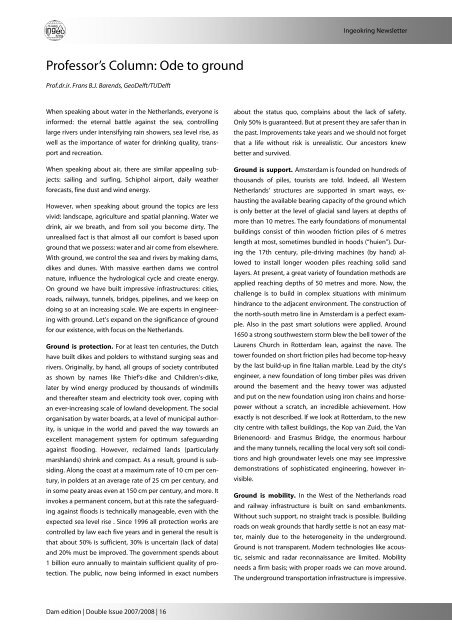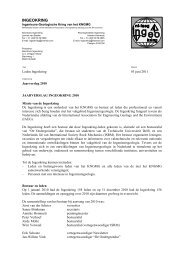News letter Dam edition
News letter Dam edition
News letter Dam edition
- No tags were found...
You also want an ePaper? Increase the reach of your titles
YUMPU automatically turns print PDFs into web optimized ePapers that Google loves.
Ingeokring <strong>News</strong><strong>letter</strong><br />
Professor’s Column: Ode to ground<br />
Prof.dr.ir. Frans B.J. Barends, GeoDelft/TUDelft<br />
When speaking about water in the Netherlands, everyone is<br />
informed: the eternal battle against the sea, controlling<br />
large rivers under intensifying rain showers, sea level rise, as<br />
well as the importance of water for drinking quality, transport<br />
and recreation.<br />
When speaking about air, there are similar appealing subjects:<br />
sailing and surfing, Schiphol airport, daily weather<br />
forecasts, fine dust and wind energy.<br />
However, when speaking about ground the topics are less<br />
vivid: landscape, agriculture and spatial planning. Water we<br />
drink, air we breath, and from soil you become dirty. The<br />
unrealised fact is that almost all our comfort is based upon<br />
ground that we possess: water and air come from elsewhere.<br />
With ground, we control the sea and rivers by making dams,<br />
dikes and dunes. With massive earthen dams we control<br />
nature, influence the hydrological cycle and create energy.<br />
On ground we have built impressive infrastructures: cities,<br />
roads, railways, tunnels, bridges, pipelines, and we keep on<br />
doing so at an increasing scale. We are experts in engineering<br />
with ground. Let’s expand on the significance of ground<br />
for our existence, with focus on the Netherlands.<br />
Ground is protection. For at least ten centuries, the Dutch<br />
have built dikes and polders to withstand surging seas and<br />
rivers. Originally, by hand, all groups of society contributed<br />
as shown by names like Thief’s-dike and Children’s-dike,<br />
later by wind energy produced by thousands of windmills<br />
and thereafter steam and electricity took over, coping with<br />
an ever-increasing scale of lowland development. The social<br />
organisation by water boards, at a level of municipal authority,<br />
is unique in the world and paved the way towards an<br />
excellent management system for optimum safeguarding<br />
against flooding. However, reclaimed lands (particularly<br />
marshlands) shrink and compact. As a result, ground is subsiding.<br />
Along the coast at a maximum rate of 10 cm per century,<br />
in polders at an average rate of 25 cm per century, and<br />
in some peaty areas even at 150 cm per century, and more. It<br />
invokes a permanent concern, but at this rate the safeguarding<br />
against floods is technically manageable, even with the<br />
expected sea level rise . Since 1996 all protection works are<br />
controlled by law each five years and in general the result is<br />
that about 50% is sufficient, 30% is uncertain (lack of data)<br />
and 20% must be improved. The government spends about<br />
1 billion euro annually to maintain sufficient quality of protection.<br />
The public, now being informed in exact numbers<br />
about the status quo, complains about the lack of safety.<br />
Only 50% is guaranteed. But at present they are safer than in<br />
the past. Improvements take years and we should not forget<br />
that a life without risk is unrealistic. Our ancestors knew<br />
better and survived.<br />
Ground is support. Amsterdam is founded on hundreds of<br />
thousands of piles, tourists are told. Indeed, all Western<br />
Netherlands’ structures are supported in smart ways, exhausting<br />
the available bearing capacity of the ground which<br />
is only better at the level of glacial sand layers at depths of<br />
more than 10 metres. The early foundations of monumental<br />
buildings consist of thin wooden friction piles of 6 metres<br />
length at most, sometimes bundled in hoods (“huien”). During<br />
the 17th century, pile-driving machines (by hand) allowed<br />
to install longer wooden piles reaching solid sand<br />
layers. At present, a great variety of foundation methods are<br />
applied reaching depths of 50 metres and more. Now, the<br />
challenge is to build in complex situations with minimum<br />
hindrance to the adjacent environment. The construction of<br />
the north-south metro line in Amsterdam is a perfect example.<br />
Also in the past smart solutions were applied. Around<br />
1650 a strong southwestern storm blew the bell tower of the<br />
Laurens Church in Rotterdam lean, against the nave. The<br />
tower founded on short friction piles had become top-heavy<br />
by the last build-up in fine Italian marble. Lead by the city’s<br />
engineer, a new foundation of long timber piles was driven<br />
around the basement and the heavy tower was adjusted<br />
and put on the new foundation using iron chains and horsepower<br />
without a scratch, an incredible achievement. How<br />
exactly is not described. If we look at Rotterdam, to the new<br />
city centre with tallest buildings, the Kop van Zuid, the Van<br />
Brienenoord- and Erasmus Bridge, the enormous harbour<br />
and the many tunnels, recalling the local very soft soil conditions<br />
and high groundwater levels one may see impressive<br />
demonstrations of sophisticated engineering, however invisible.<br />
Ground is mobility. In the West of the Netherlands road<br />
and railway infrastructure is built on sand embankments.<br />
Without such support, no straight track is possible. Building<br />
roads on weak grounds that hardly settle is not an easy matter,<br />
mainly due to the heterogeneity in the underground.<br />
Ground is not transparent. Modern technologies like acoustic,<br />
seismic and radar reconnaissance are limited. Mobility<br />
needs a firm basis; with proper roads we can move around.<br />
The underground transportation infrastructure is impressive.<br />
<strong>Dam</strong> <strong>edition</strong> | Double Issue 2007/2008 | 16




